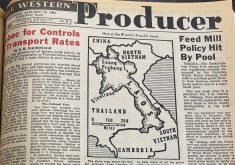“Farmers don’t need nitrogen fertilizers at all.”
With urea prices triple what they were last year, this headline caught my attention. What was this breakthrough that was going to liberate farmers from one of their largest input costs?
I clicked the link.
Clover, it turns out, can be used to fix nitrogen and boost yields in pasture forages for dairy cows. Who knew?
Oh, wait. What were those bales that used to scratch the heck out of my thighs right through my jeans when I was a kid in the 1970s? Clover. Not exactly a new idea.
Read Also

Kochia has become a significant problem for Prairie farmers
As you travel through southern Saskatchewan and Alberta, particularly in areas challenged by dry growing conditions, the magnitude of the kochia problem is easy to see.
“For every complex problem, there’s a solution that is simple, neat and wrong,” wrote American journalist and scholar H.L. Mencken.
Nitrogen is one of those problems.
On the face of it, we shouldn’t be short on N — it makes up nearly four-fifths of the air we breathe. But it takes energy and chemistry to turn nitrogen gas into compounds crops can use.
Until the early 20th century, this happened if something defecated or died or if you planted a legume or pulse crop. It wasn’t enough. By the early 20th century, governments worried about mass starvation as crop yields fell.
Then German chemists Haber and Bosch came up with the idea of sticking nitrogen and hydrogen gasses in a high heat, high pressure cooker along with a catalyst. Voila: ammonia.
Nobel prizes were awarded. The world was saved.
But wait a minute. You can get nitrogen from the air but where does the hydrogen come from? How do you power the process? Fossil fuels.
Also, crops only use about half of the nitrogen in fertilizer, with the rest often disrupting freshwater ecosystems or off-gassing as nitrous oxide, a potent greenhouse gas.
Cue the climate change alarms. It’s no surprise the federal government is keen to cut fertilizer-related emissions by 30 per cent by 2030.
Any farmer looking at this year’s inputs bill would be delighted to give up N. But cutting it to zero comes with, by some estimates, a 20 percent yield penalty that would drive margins underwater. And it would also do little to reduce early spring nitrous oxide release from soil microbes breaking down crop residue, which can account for up to 80 percent of a field’s emissions. And, and…
Well, if you see a simple, neat solution to the nitrogen problem, it’s probably wrong.

















